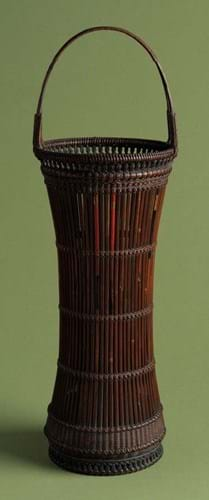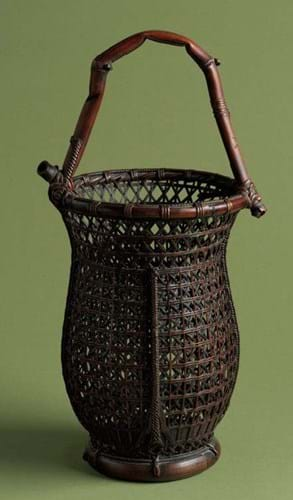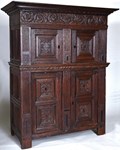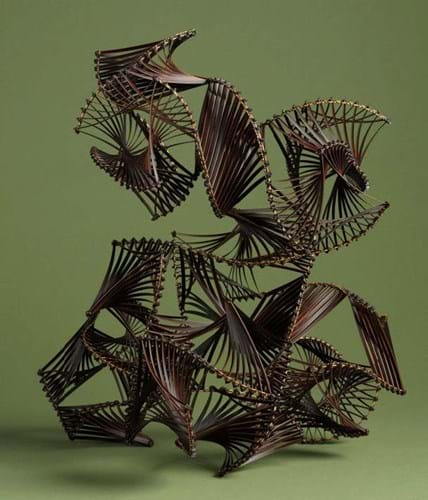
Wada Waichisai III (1899-1975), flower basket with handle, 18in (46cm) high, which is offered for a price in excess of $9000.
From deep-sided baskets to complex geometric sculptures, the art of Japanese bamboo weaving combines basic forms with intricate craftsmanship.
Around a century’s worth of these creations feature in Bamboo masterworks from Japan – classical to contemporary at Eskenazi.
It is one of two shows running at the Asian art specialist in Mayfair, London, from June 1-30.
Continuing a programme the firm launched last year, the exhibition is one of two running simultaneously in a bid to promote lesser-known eastern arts and bring in a new generation of buyer.
The other one is Contemporary, focusing on Chinese porcelain artist Fang Lijun (b.1963).
Bamboo master
However, the bamboo show spans a much earlier date range including the work of early 20th century maker Tanabe Chikuunsai I (1877-1937), considered one of the fathers of modern Japanese bamboo art.
The third son of a physician, he was apprenticed to a bamboo master by the age of 12.
The master conferred on him the name ‘Chikuunsai’ meaning ‘Bamboo Cloud Studio’.
He worked partly in the Chinese style, which was dominant at the time, making use of classical forms, high handles and intricate plaiting.
However, he also innovated using his own style and techniques. In some pieces, such as the basket pictured here, he made use of recycled materials – in this case old arrow shafts.
Traditionally bamboo in Japan was used to display flowers or fruit to accompany tea ceremonies. Tanabe Chikuunsai I, who also achieved master status in flower arranging and sencha tea ceremony, used his knowledge of these arts to inform his woven designs.
His work contributed to a change in perception of bamboo art during the Meiji period (1868-1912). It was no longer regarded as being artisanal production and instead was viewed as studio art.
Four generations
There have now been four generations of Tanabe Chikuunsai bamboo weavers, three of whom are represented at the Eskenazi show.
The youngest in the dynasty, Tanabe Chikuunsai IV (b.1973), is known for his mathematical creations and free-form installations, including those at the Metropolitan Museum of Art in 2017 and the Museé Guimet in Paris.
He and his predecessors are among 18 artists featured, contributing 31 works of art.
Others include Sakaguchi Sounsai (1899-1967), who was mentored by Tanabe Chikuunsai I, Maeda Chikubosai I (1872-1950), who worked alongside the master from c.1912, and Iizuka Shokansai (1919-2004), who was dubbed a ‘Living National Treasure’ in the field of bamboo art by the Japanese government.
According to the gallery, Japanese bamboo art was little known in the West until recently. Thanks to exhibitions such as Japanese Bamboo Art: The Abbey Collection, held at the Metropolitan Museum of Art in 2017 and Art of Bamboo in Japan hosted by the Quai Branly Museum in Paris, 2019, it has enjoyed a recent surge in popularity.
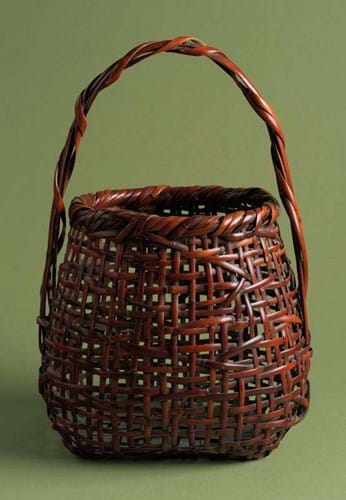
Sugiura Noiyoshi, Uzunari (Sound of the Whirlpool), 2018, 20in (50.5cm) high, which is offered for a price in excess of $15,000.
Works in the Ezkenazi show are offered at prices ranging from $4000-32,000.
See clearly now
The two Eskenazi exhibitions overlap with the second edition of the Asian Art in London Summer Event, from June 28-July 1.
St James’s gallery Priestley & Ferraro has also announced an exhibition for that event. Mist and Clarity offers 46 works by Chang Chien-ying (1909-2003) and Fei Cheng-wu (1911-2000), the first Chinese academically trained artists to settle and work in Britain.


